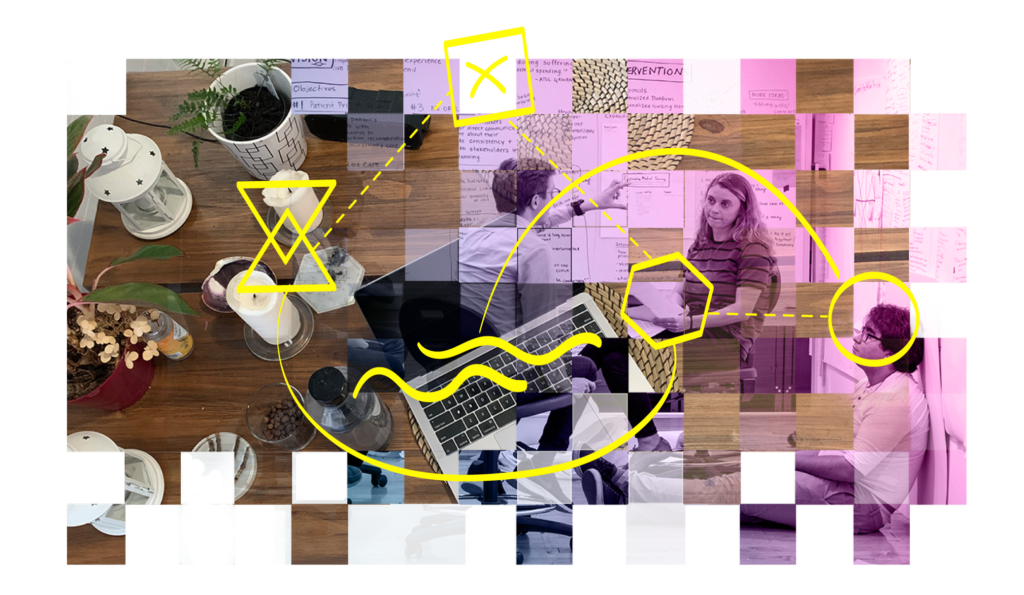
When we attempt to address the conditions of quarantine, natural disaster and social unrest it’s easy to begin by listing what we’ve lost, because we’ve lost a lot. What if we asked what is gained?
As practitioners at the intersection of learning and design, and as thinkers situated in a studio oriented institution, the studio is an anchor and foundation to our work. Every day as we proceed through this moment in time we are challenged to ask where, who and what our studios are, because last year’s answers to that question no longer suffice. Do we know our studios well enough to nurture the elements of studio time, collaboration and practice that we need most right now?
What follows after this introductory piece is a series that seeks to interpret this moment through the mercifully narrow keyhole of studio thinking, work and exchange.
To kick that off, here are three categories that we can use to pivot our thinking away from the losses and toward the gains.
- Synchronous and asynchronous time
- Shared and personal space
- Mediated encounters
In and out of synchronous time
When a studio is embedded in the home, the beginning and end of studio time is based on how work integrates into the other activities of home life. The “when” of the studio is no longer designed around mobility or institutional operating hours. Each member of a studio has distinct constraints to keep their household operational, so we can’t rely on our temporal patterns matching up with the patterns of the people with whom we work.
When we lose the uniformity of shared time we gain the agency to determine when studio time fits into the rest of our life, and the challenge to protect and honor that time. When our work is more closely knit into our lives, how does that influence our work? Do we consider these “interruptions” of caregiving and intimate relationships as something other than interruptions? Does this moment induce a generative reframing of our past studio time as decontextualized, and frame the present as being highly contextualized and therefore full of the beneficial complexity, friction and texture of vitality?
Spatial homogeny and variety
A shared studio is distinct from the diaspora of personal spaces because it provides an empty, common, material and spatial template to those practicing within it. We import discovery artifacts and raw materials into the studio to practice material interrogations, and as we practice the empty spatial template is filled by the variety that is ourselves and our work. As we generate and display that work in the studio, we are filling an empty template. When we work at home we making in already full, deeply human, materially heterogeneous contexts with their own aural and visual properties. Our homes are active sites, rich with nuance, and the work we make here is informed by everything the home-as-site has to offer us. When the time comes to encounter each other’s work, that work can benefit from being situated in these sites. What if we take agency in the home-as-site opportunity? What if the way our spaces and the work is mediated to the outside gaze is as intentional as the work itself?
Intentional mediation
The ceremonial tradition of design presentations occur in deeply familiar spaces. We paint a very spatial mental picture when we think of an academic studio pinup, a final critique, a professional first look meeting or a final presentation to a client,. To some extent these rituals are inextricable from the sites in which they occur, and it’s challenging to imagine a different site, or a different process, because the studio was always there for us. Now that the studio conditions have changed, a designer is charged to ask the questions that media studies scholars have been investigating for decades: what media might we choose to produce the encounters we seek to have? While we’ve lost the benefit of body language communication, tactility and water cooler moments, we’ve gained the precision required by and amplification provided my other mediums, including digital ones. Indeed it takes a significant amount of work to exercise agency in assembling a media ecosystem that advances our work. It also takes a significant amount of thought to exercise agency when using media ecosystems that may be imposed on us. The studio protected us from these matters, and suddenly that protection is gone.
As designers the overwhelming challenge and vastness of the opportunity space is a bit stunning, but I think we’re going to rise to the challenge, because we’re designers. We hope that that writing that follows this introduction brings you a bit of peace and reflection to mitigate the chaos of everything 2020 is bringing us. We would love to hear from you if you find these pieces moving or inspiring, and of course if you find them worthy of robust critique.
– Written by Katie Edmonds. September 2020.
